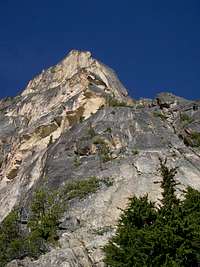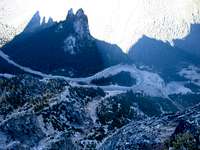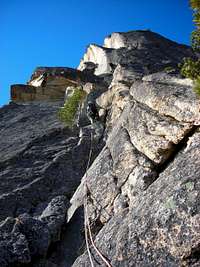|
|
Route |
|---|---|
|
|
48.51200°N / 120.65546°W |
|
|
Mountaineering |
|
|
Summer, Fall |
|
|
Most of a day |
|
|
5.10 (YDS) |
|
|
III+ 5.9 A0 or 5.11 |
|
|
9 |
|
|
III |
|
|
Overview
Most TR’s on this route share a common sentiment: this is a handsome line when viewed from the hairpin turn below but climbing is not that outstanding (though pretty good). Rock is solid overall though covered in the “kitty litter” stuff (typical of some WA Pass routes) in places. In my humble opinion, East Face of Lexington (another grade III+ east side classic) is better and the “high’s” on East Face of Minuteman (splitter cracks on the upper half) are “higher” than any pitch on this line (though nothing is as shitty on this one as the lower half of the Minuteman line). This is a Fred Beckey (and Doug Leen) classic from 1968. Enjoy.Getting There
Drive the North Cascades Highway (WA state route 20) to 0.5 miles east of Washington Pass. Park at the dirt pullout at the obvious hairpin turn directly beneath the east faces of South (on left) and North (on right) Early Winter Spires.Hike up the obvious gully that provides easy passage through the first steep band of cliffs. Above this low cliff band, a faint climbers’ path will take you out of the gully on a gentle rightward climb traversing easy slabs and vegetated dirt slopes. About 45 minutes out, you’ll come to some 4th class slabs. The way we went, the slabs felt harder and we simul-climbed up and right to the toe of the east buttress/prow of South Early Winter Spire (low point of buttress just left of the gully separating North and South Early Winter Spires). This is the start of the route as described in Nelson and Potterfield guidebook.
Route Description
Pitch 1: 5.6, 160+ feet. Climb low angle and ledgy terrain up toward the left facing dihedrals above. Belay before terrain steepens (many options).Pitch 2: 5.8, 100+ feet. Climb up the steeper terrain heading for the dihedrals. Your passage is the left (& less steep) of the two left-facing dihedrals. Climb the dihedral and traverse left under a roof and up another (awkward) dihedral to a large ledge with a good-sized tree.
Pitch 3: 5.9+, 160 feet. Despite the N&P ratings, this pitch did not feel much harder than the previous. Climb up the left facing dihedral with a nice crack to another roof. Move left around the roof (crux) and continue up progressively easier terrain. N&P would have you belay somewhere here but it’s easy enough to just link the next short (& easy) pitch. Continue moving up the ledgy terrain. When terrain steepens, move right and then slightly down onto another huge ledge (look up and see a traversing bolt ladder above you).
Pitch 4: 5.8 A0 or 5.10+, 100 feet. Climb up the face to reach the first bolt of the ladder. Climb the bolt ladder (A0 or 5.10+ face) up and right eventually pulling around a corner onto the east buttress proper. Enjoy the exposure. Clip a couple more bolts and then make a face move to a short and thin crack. Climb crack (5.8-5.9) 10 feet to a hanging belay on good bolts. I suggest belaying here.
Pitch 5: 5.10- A0 or 5.10 (?), 70 feet. From hanging belay, traverse right (2 bolts) to an ugly thin crack. Crack becomes better higher. Above, move up the face and slightly right. Questionable gear in intermittent cracks. The crux face move is done with finger sized cam below your feet placed in a questionable groove. Clip one bolt just above the crux move and belay on a sloping ledge on the right (OK gear).
Pitch 6: 5.10- A0 or 5.11 (?), 140+ feet. Traverse easy terrain back left and climb the bolt ladder up through the bulge to the right facing dihedral. Pull a mantle move left out of the dihedral and climb another bolt ladder above. One more mantle move of similar difficulty and the terrain eases. Belay when convenient.
Pitch 7: 5.6, 180+ feet. Move right and up the easiest line. Belay when out of rope or drag stops you.
Pitch 8: low 5th, 180+ feet. Continue moving up progressively easier terrain until you top out on a hump separated from the summit by a narrow ridge. Belay on good bolts.
Pitch 9: low 5th, 140 feet. Move down and walk the ridge toward the summit. Either tag the summit (on right and 30 feet of 4th class above) or start your scramble down the South Arete (left).
Descent: Scramble down the South Arete route. Mostly class 3 (fairly exposed) with some class 4 steps and 2 rappels over short 5th class sections (upper one being the chimney).
Once on the ground, hike down west and pick up the climbers’ trail that shadows the west side of the spires on a gentle descent. Follow it to the Blue Lake Trail which in turn brings you to the highway. Hike ~2 miles east along highway back to the hairpin.
The direct descent down the steep talus (east) to the hairpin did not look appealing (maybe better earlier with snow?).
Essential Gear
Small set of nuts. Double set of cams from green Alien to #3 Camalot. Optional 3rd set of finger sized cams and single #3.5 Camalot. Lightweight aiders & a fifi might be nice if aiding the ladders but you can probably just yard on draws.External Links
(1) Very nice TR with good photos is here....more when I find them.








